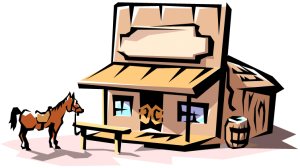 One hundred and twenty years ago the scene in the American West would have been familiar. The scorching air would have been thick and dusty. The only street through the town of rickety boarded buildings would be crowded with cowboys and their horses. The one refuge from the oppressive conditions was the local saloon. And that was where you found all manner of folks. The tired cowhands, the frontier entertainers and the bad guys would be there. Everyone knew that the bad guys always came to the saloon looking for trouble. It was not a place for the unprepared or naïve because they were easily recognized and exploited. Winning for the bad guys was dominating the saloon.
One hundred and twenty years ago the scene in the American West would have been familiar. The scorching air would have been thick and dusty. The only street through the town of rickety boarded buildings would be crowded with cowboys and their horses. The one refuge from the oppressive conditions was the local saloon. And that was where you found all manner of folks. The tired cowhands, the frontier entertainers and the bad guys would be there. Everyone knew that the bad guys always came to the saloon looking for trouble. It was not a place for the unprepared or naïve because they were easily recognized and exploited. Winning for the bad guys was dominating the saloon.
Still, there weren’t many options for places to go. It was a given that sooner or later the good guys went there too.
So you might imagine going there with a friend. Ah, your friend. The paragon of truth and justice. A cowboy that was strong and good. He represented all that right about the world and that is exactly what made him a target. Others (the bad guys) could not prosper when he was there and they knew it.
As a friend, how would you prepare him for the saloon so that he could walk out alive?
There are 5 things that you might do.
- Scout the saloon. You would survey who frequented the saloon, when the bad guys usually showed up and how the dynamics changed when they did.
- Check the entrances and exits. This could be critical if a gunfight erupted. Knowing the design of the saloon building could come in quite handy if a quick escape or a different plan was required.
- Chose the seating. Certain tables would be more or less vulnerable to attack. Usually the corner table was best because it gave the best vantage point. No one could come in behind your friend and all of the action would be in front of him.
- Recruit some allies. It is rare that everyone would be against your friend. However it is possible that they would not be organized to help him. You would work on this ahead of when they were needed.
- Give an early warning. The proverbial bad guys always announced their arrival and usually their intentions. The sooner the good guy knows that they will sooner enter the saloon, the better prepared he (and his allies) will be. You would be actively watching.
If you did these five things, your friend would have a lot of advantages. He would be ready to proactively respond to whatever came his way. It is more likely that his day would go well and that the bad guys malevolent intents would be thwarted.
Now change the terms to a present day situation. The “saloon” becomes the competitive environment. The “good guys” become your company or client. The “bad guys,” of course, are your competitors. The “entrances and exits” are your strategic options. The “seating” is your market or product position. The “allies” are your alliance partners and ecosystem. Finally, the “early warning” becomes your gap analysis process.
Our jobs in competitive intelligence are to help the “good guys” win against competitors. We orchestrate many things to proactively equip senior management with what they need to know about the environment, specific competitors and possible strategic options. Our jobs matter because few other functions have such a broad portfolio of tasks that affect the “safety” of the company in a dangerous competitive landscape.
Living and working in a competitive environment is not an option for most companies. There are competitors and dangers. There are outcomes which are harmful to our clients or companies. There are others that are aggressively pushing their agendas which will diminish the our prospects. Luckily we are far from helpless.
We fight back with “saloon lessons” to equip our management better.
May the good guys carry the day. Giddy up.


no comment until now